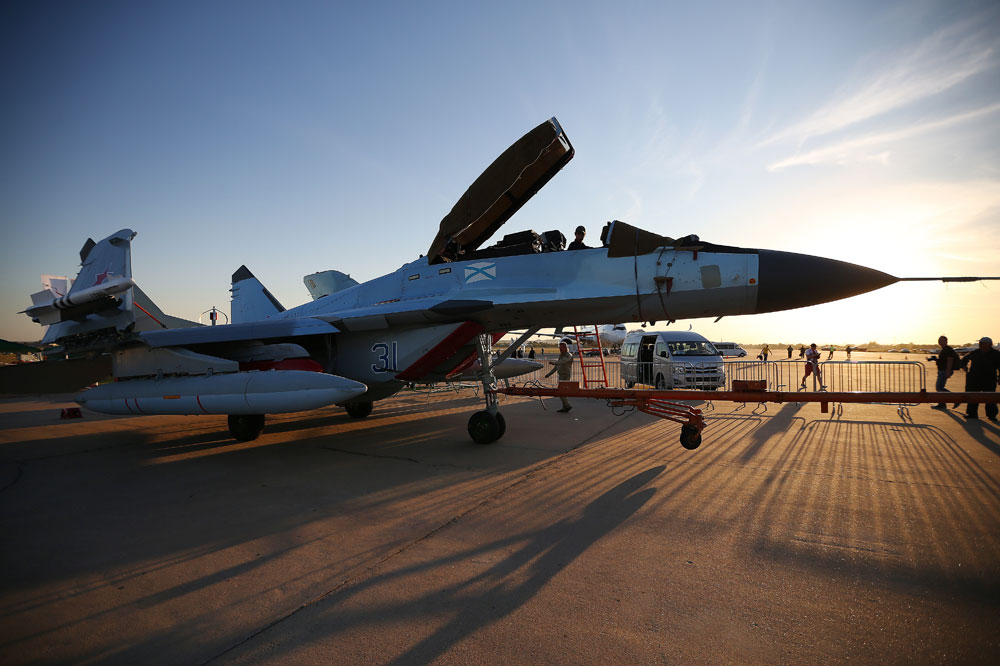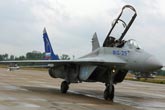MiGs make a comeback – at sea

A MiG-29K fighter jet on display at the opening of the 2015 MAKS International Aviation and Space Salon in the town of Zhukovsky, Moscow region.
Sergei Bobylev / TASSFormer Air Marshal Sumit Mukerji holds a rare distinction. The Indian Air Force officer, who was Air Officer Commanding-in-Chief, Southern Air Command, is the only air force pilot to have commanded MiG-21, MiG-23, MiG-25, MiG-27 and MiG-29 units. "The only pilot," he says. "There’s no one even in Russia.”
Mukerji’s achievement was possible because of the dominance of MiG aircraft in the IAF fleet. Currently the IAF has 245 units of the MiG-21 interceptor and 120 units of the MiG-27 ground attack jet. The MiG-23 fighter-bomber and the MiG-25, of which the IAF had eight units of the reconnaissance version, are long retired.
Although MiG-21s are still in use in as many as 19 air forces worldwide, the frequent crashes of these older IAF MiGs led to a trial by media and furore in parliament, after which the IAF announced it would retire MiG-21s and MiG-27s in the near future.
However, early retirement looks unlikely as replacement aircraft aren’t coming in fast enough. The Rafale deal with the French has hit cost turbulence and the locally made Tejas is not a proven design – at least not yet. Also, HAL’s Tejas production rate is too low – 12 per year although it could go up next year – for the ‘Made in India’ jet to replace all MiG-21s.
Navy Fulcrums
But even as hundreds of older MiGs are set to fly into the sunset, the Mikoyan-Gurevich presence in India will continue for several more decades. This is because of the presence of the powerful MiG-29 multirole fighter - codenamed Fulcrum by NATO - in both the IAF and the Indian Navy.
The IAF currently has 69 MiG-29s, which are expected to serve at least until 2030. India was the first international customer of the MiG-29. The IAF placed an order for more than 50 MiG-29s in 1980 while the aircraft was still in its early development phase.
While the IAF may not place further orders for the aircraft, the Indian Navy has ordered as many as 45 naval variants. In fact, Russia revived the MiG-29K programme in the late 1990s in response to the Indian Navy's decision to acquire the aircraft carrier Admiral Gorshkov, refurbished as INS Vikramaditya.
The Indian Navy is currently looking at the MiG-29K as an option for its future aircraft carrier INS Vishal. Russian Aircraft Corporation MiG has expressed its readiness to supply the required number of MiG-29Ks. According to senior MiG executive Anastasia Kravchenko, India’s Ministry of Defence has asked four countries to send proposals for the supply of fighter jets for the country’s second indigenously built aircraft carrier, which will carry more than 50 aircraft.
INS Vishal could be the first Indian carrier to field a catapult launched but arrest landing (CATOBAR) aircraft launch system. The CATOBAR would allow the MiG-29K to take off at near maximum payload and fuel, which would allow the aircraft to utilise its range of 1300 km.
Having long-range strike and reconnaissance aircraft translates into better survivability for carriers because they can operate further away from enemy shores. Also, enemy hunter killer submarines will have to operate in the open seas, increasing their vulnerability to carrier-borne aircraft.
MiG dominance
MiG series aircraft formed the backbone of the IAF’s strike element for more than four decades. The first dogfight between supersonic aircraft took place during the December 1971 War with Pakistan when two MiG-21s over Jamnagar, Rajasthan, chased two American built F-104 Starfighters of the Pakistan Air Force. While one Starfighter escaped, the other was shot down by the MiG over the Arabian Sea.
Military analyst Edward Coggins writes in ‘Wings That Stay On: The Role of Fighter Aircraft in War’ that by the time the hostilities came to an end, the IAF MiG-21s had claimed four Pakistani F-104s, two F6 jets, one F-86 Sabre and one Lockheed C-130 Hercules. The Russian fighter had clearly won the much anticipated air combat between the MiG-21 and the F-104, he writes.
Thrilled with the MiG-21’s success, India went on to acquire newer MiG models.
Pack attack
One the most glorious chapters in MiG fighter history was during the 1999 Kargil War when the IAF threw all its MiGs in a massive offensive against the Pakistani intruders.
In the report ‘Airpower at 18,000 feet: IAF in the Kargil War’ published by the Carnegie Endowment for International Peace, Benjamin Lambeth explains in detail how the IAF ground down both the Pakistan Army and the PAF.
In the early hours of May 26, 1999 six attacks in succession by MiG-21, MiG-23 and MiG-27 fighters were launched against intruder camps, material dumps, and supply routes in the areas overlooking Dras, Kargil and Batalik.
The MiG-21bis squadron at Srinagar was joined by additional MiG-21M, MiG-23BN and MiG-27ML squadrons, while additional squadrons of MiG-21Ms and MiG-29s deployed northward to Avantipur. While the MiG-29s kept the Pakistani F-16s bay, the other IAF aircraft (including the French Mirage 2000) carried out ground sorties.
An example of Indian ‘jugaad’ – or improvisation – was the use of stopwatches and handheld GPS receivers in their cockpits by MiG-21 pilots lacking sophisticated onboard navigation suites. According to Prasun K. Sengupta in “Mountain Warfare and Tri-Service Operations”, another novel technique developed by the IAF for use in the campaign entailed selecting weapon impact points so as to create landslides and avalanches that covered intruder supply lines.
The IAF used the MiG-25R – which normally flies at 80,000 ft – in a medium altitude role to improve the resolution of its pictures, something that the aircraft’s Russian designers may not have thought possible.
Lambeth emphasises the complete dominance achieved by India’s MiG-dominated fleet. “Throughout the campaign, whenever IAF reconnaissance or ground attack operations were under way in the immediate combat zone, Western Air Command ensured that MiG-29s or other air-to-air fighters were also airborne on combat air patrol stations over the ground fighting on India’s side of the Line of Control to provide top cover against any attempt by the PAF to enter the fray in a ground attack role. PAF F-16s to the west typically maintained a safe distance of 10 to 20 miles on the Pakistani side, although they occasionally approached as close as 8 miles away from the ongoing ground engagements.”
The PAF’s director of operations during the Kargil War later reported that there had been isolated instances of IAF and PAF fighters locking on to each other with their onboard fire control radars, but that caution had prevailed on both sides and that “no close encounters took place”.
IAF fighters never joined in aerial combat with the PAF F-16s due to the A.B. Vajpayee government’s strict injunction that Indian forces not cross the Line of Control. Seven years later, however, Air Chief Marshal A.Y. Tipnis recalled that he had personally authorised his escorting fighter pilots to chase any Pakistani aircraft back across the Line of Control in hot pursuit were those pilots to be engaged by enemy fighters in aerial combat.
Looking forward, with the IAF’s Sukhoi Su-30 fleet set to touch a figure of 300 or more in the next decade, the MiGs will be reduced to a small – albeit important – component of India’s strike forces. They may have ceded space in the IAF to the superior firepower of the Sukhois, but the MiGs are now about to stamp their dominance over the seas.
All rights reserved by Rossiyskaya Gazeta.
Subscribe
to our newsletter!
Get the week's best stories straight to your inbox



